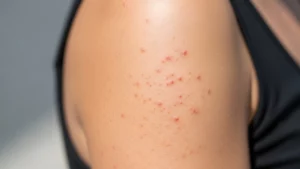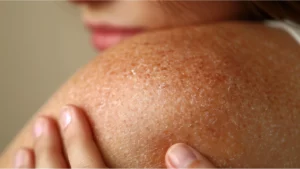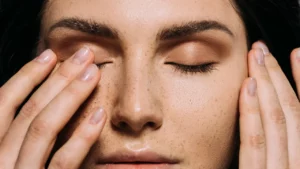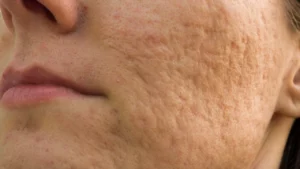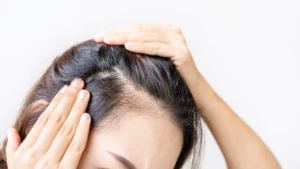Table of Contents
As skincare evolves, new ingredients rise to prominence, pushing boundaries and offering next-level hydration and care. Enter Polyglutamic Acid (PGA) – a game-changing ingredient that promises to revolutionize the way we think about skincare hydration. With its ability to bind up to 4,000 times its weight in water, PGA is four times more hydrating than the widely-known Hyaluronic Acid, making it a powerful addition to your skincare routine in 2025.
In this blog, we’ll dive into why Polyglutamic Acid is set to dominate skincare trends, and how you can incorporate it into your routine to achieve smoother, plumper, and deeply hydrated skin.
What is Polyglutamic Acid?
Polyglutamic Acid (PGA) is a naturally derived amino acid polymer that has been gaining attention for its incredible ability to hold water. It is produced through a fermentation process and can bind a significant amount of moisture to the skin. This ingredient is often found in moisturizers and serums, and when used correctly, it delivers extreme hydration by preventing moisture loss from the skin barrier.
PGA is derived from glutamic acid, an amino acid commonly found in foods like soy sauce, seaweed, and fermented products. It plays a role in maintaining the hydration levels of the skin by improving the skin’s moisture retention abilities. The result is a glowing, smooth, and plump complexion.
Polyglutamic Acid vs. Hyaluronic Acid: The Ultimate Hydration Showdown
Hyaluronic Acid (HA) has long been the champion of skin hydration, boasting the ability to hold up to 1,000 times its weight in water. However, Polyglutamic Acid has now emerged as a hydration powerhouse, binding a massive 4,000 times its weight in water, far surpassing HA in its water retention capabilities.
But how do they differ when it comes to skin care?
Hyaluronic Acid:
- Attracts moisture to the skin’s surface.
- Works well for all skin types, including oily and acne-prone skin.
- Can lose its effectiveness in very dry environments due to its tendency to draw moisture from deeper layers of the skin when external hydration is insufficient.
Polyglutamic Acid:
- Binds 4,000 times its weight in water, providing long-lasting hydration.
- Forms a protective barrier over the skin to lock in moisture.
- Acts as a superior hydrating agent, especially beneficial for dehydrated, dry, or flaky skin.
- Works synergistically with Hyaluronic Acid to enhance moisture retention and skin softness.
In short, while Hyaluronic Acid is great for drawing moisture into the skin, Polyglutamic Acid seals it in, creating a hydrating, dewy finish that lasts longer.
Benefits of Polyglutamic Acid for Your Skin
1. Extreme Hydration PGA’s unique ability to retain moisture makes it a must-have ingredient for skin that is constantly in need of hydration. It keeps the skin’s moisture locked in, preventing it from evaporating and ensuring a plump and smooth texture throughout the day.
2. Reduces Dryness and Flakiness For those suffering from dry or flaky skin, PGA can be a savior. It helps to smooth rough patches and reduce the appearance of flakiness by ensuring your skin retains adequate moisture levels.
3. Plumps and Firms the Skin By improving moisture levels, Polyglutamic Acid helps to smooth the skin’s texture and reduce the appearance of fine lines and wrinkles. Over time, this leads to firmer, more youthful-looking skin.
4. Enhances the Effectiveness of Other Skincare Products PGA not only hydrates but also acts as a carrier for other skincare ingredients, improving their absorption into the skin. When paired with ingredients like Snail Mucin or Emollients, it locks in moisture while allowing other beneficial compounds to penetrate deeper into the skin.
5. Improves Skin Barrier Function PGA forms a thin, protective barrier on the skin, helping to strengthen the skin’s natural barrier and preventing moisture loss. This is crucial for maintaining optimal skin health, especially in harsh weather conditions.
How to Use Polyglutamic Acid in Your Skincare Routine
1. Apply on Damp Skin For optimal hydration, Polyglutamic Acid should be applied to damp skin. The reason for this is that it works best when it can trap moisture, enhancing hydration from the inside out.
2. Seal with a Moisturizer To maximize the effectiveness of PGA, seal it with a good moisturizer. The moisturizer helps lock in the moisture that PGA has attracted, ensuring long-lasting hydration.
3. Combine with Snail Mucin or Emollients For the ultimate hydration boost, Polyglutamic Acid can be paired with Snail Mucin or emollients. These ingredients not only nourish and hydrate the skin but also work synergistically with PGA to lock in moisture and promote smoother, more even skin.
4. Avoid If You Have Sensitive or Acne-Prone Skin Although Polyglutamic Acid is generally safe for most skin types, it may not be suitable for those with sensitive or acne-prone skin. If you have these conditions, consult with a dermatologist before adding PGA to your routine.
Who Should Use Polyglutamic Acid?
Polyglutamic Acid is perfect for anyone looking for intense hydration and moisture retention, especially those with dry, dehydrated, or flaky skin. It is also beneficial for individuals with aging skin, as it helps to plump the skin and reduce the appearance of fine lines.
However, those with sensitive or acne-prone skin should be cautious and perform a patch test before using products containing PGA. Book a free consultation with us.
Polyglutamic Acid in 2025: The Future of Skincare
As we enter 2025, Polyglutamic Acid is poised to become a leading ingredient in skincare. Its ability to hydrate four times more effectively than Hyaluronic Acid, combined with its versatile applications, will make it an essential part of skincare routines for individuals seeking dewy, youthful, and plump skin.
With its growing popularity in the beauty industry, Polyglutamic Acid is already being incorporated into some of the most advanced skincare formulations available. Expect to see it in serums, moisturizers, and masks as brands continue to innovate and push the boundaries of skincare technology.
Conclusion
Polyglutamic Acid is a powerhouse ingredient set to dominate skincare trends in 2025. Its unparalleled ability to retain moisture makes it an ideal solution for dry, flaky skin, offering long-lasting hydration, smoother texture, and a plumper, youthful appearance. Whether you pair it with Snail Mucin or Emollients, Polyglutamic Acid is an essential addition to your skincare routine.
If you’re looking to achieve next-level hydration and radiance in 2025, it’s time to introduce Polyglutamic Acid into your regimen. For more information call with us today.
1. What is Polyglutamic Acid, and why is it better than Hyaluronic Acid?
Polyglutamic Acid is an amino acid polymer that binds up to 4,000 times its weight in water, making it far more hydrating than Hyaluronic Acid. It provides long-lasting moisture and locks hydration into the skin.
2. Can Polyglutamic Acid be used for sensitive skin?
While it is generally safe for most skin types, those with sensitive or acne-prone skin should perform a patch test first and consult with a dermatologist before use.
3. How do I incorporate Polyglutamic Acid into my skincare routine?
For optimal results, apply Polyglutamic Acid to damp skin and follow with a moisturizer to lock in hydration. For added benefits, pair it with Snail Mucin or emollients.
4. Is Polyglutamic Acid suitable for aging skin?
Yes! Polyglutamic Acid helps plump the skin and reduce the appearance of fine lines, making it an excellent choice for those with aging skin looking for a hydration boost.
5. When will Polyglutamic Acid become widely available?
Polyglutamic Acid is already being incorporated into skincare products, and it is expected to become widely available and popular in 2025, with many skincare brands adopting it as a key ingredient.


